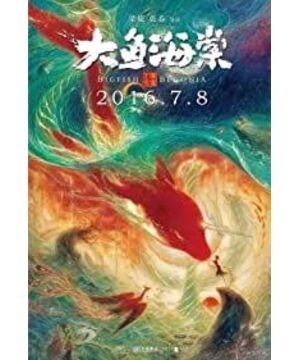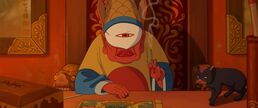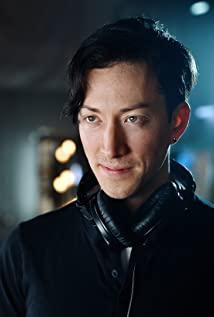In "Big Fish and Begonia", at the beginning of the film, Lao Chun explained the world she belongs to. They who grew up in the underwater world are not gods or people, but "other people". Since they are both human, it means that Chun and Kun are not "cross-species", at best they can only be regarded as "cross-nationality". But weird is weird because they are both human. Before the end of the story, Kun and Chun appeared in the form of two species, especially when the two met for the first time, the girl who transformed into a red dolphin fell in love with the beautiful young Shang. Understandable, but it's a bit weird for a beautiful teenager to fall in love with a dolphin.
The biggest problem between Kun and Chun is not to cross species, but to cross life and death. Kun, which exists as a fish, is essentially a dead man. Tsubaki's mission is actually "to bring Kun back to life" rather than "to restore Kun to human form", although in this film, these two things are the same thing. So here comes the problem. From naming the film to promoting the film, the main creator puts too much emphasis on "fish" and raises the public's expectations for "cross-species love" too high. In fact, based on the setting of the story, this is just another The version of "The Love of People and Ghosts is Over", or it can be called "Unrequited Love of People and Ghosts", because Kun, as a fish, can only be cute, and it is more like a pet.
But the biggest noise at present is still focused on Tsubaki's Mary Su character. But when Chun decided to save Kun, he had just passed his coming-of-age ceremony, which was equivalent to a teenage girl. The story of a teenage girl eloping for love, martyrdom, betrayal and separation, don't we read less in social news and fictional works? ? What really makes people feel awkward is not that a child would do such a thing, but that even if the child is mature and old, she has no remorse for the fatal damage she caused. This story is backtracked from the perspective of the old Chun. From the beginning of the film, there is a vicissitudes of life representing the old Chun as a narration throughout the whole film. The audience feels that the story is inconsistent. The most important thing is that the story is told from the mouth of the old Chun. of.
Because the narration of this film is not only narration, but also includes the monologue and psychological activities of the protagonist, so when the screenwriter writes the narration, it must be written as a character's lines, and it must be in line with the character's gender, age, identity, Even though the image of the old Tsubaki has never appeared on the screen in the form of pictures from beginning to end, the screenwriter still has to regard the narration as an old woman and shape the role. As for why Tsubaki who became a mortal does not lose his memory, and whether the resurrected Kun still remembers their past, these are not important, the important thing is that they are together at the end of the story.
But in a film where the picture wins, the use of narration is a colossal failure. The main creator is not good at showing the structure of a new world with pictures, and can only rely on narration to supplement the structure and division of labor in this world. Even if it is an animation for children, is there any narration in "Inside Out" that distinguishes reality from fantasy?
The audience's perception of the world in this story comes not from the picture, but from the narration at the beginning of the film - the world she lives in, the sky is connected to the seabed of the human world, and after human beings die, the soul will become fish into their world. This complex setting is quite ambitious, even subverting myths, legends and religious books, and beyond the imagination of the creator.
From the visual point of view, this "other people's world in charge of the souls of the dead" is not much different from the human world. There are four seasons, life, old age, sickness and death, firewood, rice, oil and salt, and commercial transactions. However, in human society, transactions often have a clear purpose of accumulating wealth. In this world, every time a spirit woman negotiates conditions with people, she asks others to sacrifice their life or keep their body organs.
A small suggestion to the main creator: the transaction here can also be improved with visual effects. Whenever the spirit woman trades with others, the exchange conditions can be turned into specific objects for the spirit woman to collect. For example, half of the lifespan can be turned into a coin, and the eyes can be turned into a gem. Over time, the spiritual woman will have a huge treasure trove. It must be quite shocking and impactful to be able to use the picture to show the rich inventory of the spiritual woman.
Regrettably, the main creator not only does not know how to use pictures to construct a new world and worldview, but also does not know how to use pictures to describe characters and their psychological activities. When Chun decided to save Kun, I couldn't see the excitement in her eyes, nor did she make any effort to save Kun, I could only rely on the dry narration of "I know this is my life. turning point".
On the contrary, Qiu is the decisive factor in the success of this relationship - from Chun's decision to save Kun, to Kun's being abandoned by Chun's mother, Qiu was helping her after the aftermath, and Qiu almost lost his life in order to kill the two-headed snake. Because of this all-purpose spare tire, Chun's life is too easy. It is Qiu, not her, who has been giving and sacrificing for Kun. It's no wonder that she ended up betraying everyone. The audience was not moved at all, but felt that she deserved it. And since the main creator wants to portray Qiu as a tall and complete image, he should simply be taller, bigger and more complete, and the sense of presence should be higher, otherwise how can he reflect the tragic effect when he was rejected by Chun?
If I were to sum up the fatal injury of "Big Fish and Begonia" in one word, it would not be "Mary Sue", but "no drama". Everyone's actions are based on their own moral fantasies, not decisions made after interacting with and understanding others. If there is no interaction between characters, there will be no complex dramatic contradictions, and without drama, the picture is still static no matter how beautiful it is.
FOR "The Paper"
View more about Big Fish & Begonia reviews











